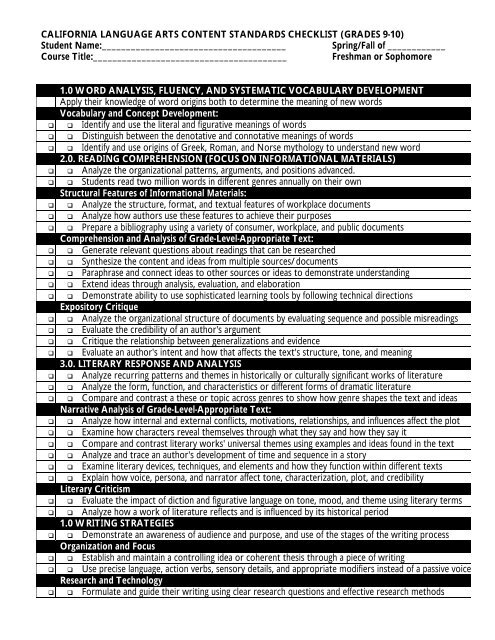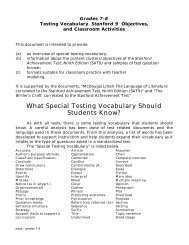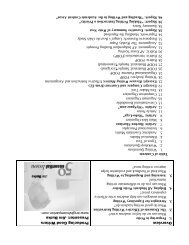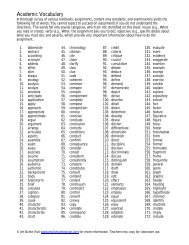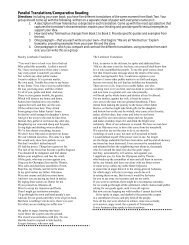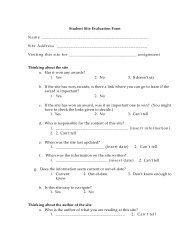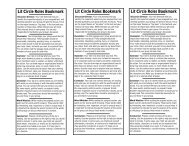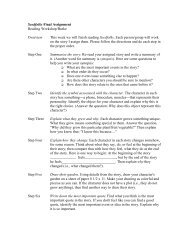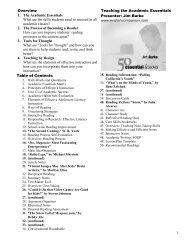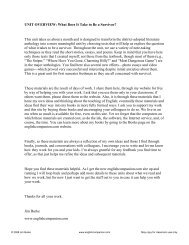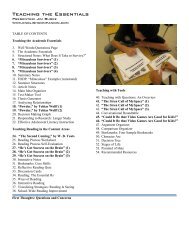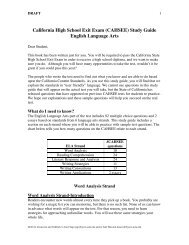California language arts content standards checklist - English ...
California language arts content standards checklist - English ...
California language arts content standards checklist - English ...
You also want an ePaper? Increase the reach of your titles
YUMPU automatically turns print PDFs into web optimized ePapers that Google loves.
CALIFORNIA LANGUAGE ARTS CONTENT STANDARDS CHECKLIST (GRADES 9-10)<br />
Student Name:______________________________________ Spring/Fall of ____________<br />
Course Title:________________________________________ Freshman or Sophomore<br />
1.0 WORD ANALYSIS, FLUENCY, AND SYSTEMATIC VOCABULARY DEVELOPMENT<br />
Apply their knowledge of word origins both to determine the meaning of new words<br />
Vocabulary and Concept Development:<br />
q q Identify and use the literal and figurative meanings of words<br />
q q Distinguish between the denotative and connotative meanings of words<br />
q q Identify and use origins of Greek, Roman, and Norse mythology to understand new word<br />
2.0. READING COMPREHENSION (FOCUS ON INFORMATIONAL MATERIALS)<br />
q q Analyze the organizational patterns, arguments, and positions advanced.<br />
q q Students read two million words in different genres annually on their own<br />
Structural Features of Informational Materials:<br />
q q Analyze the structure, format, and textual features of workplace documents<br />
q q Analyze how authors use these features to achieve their purposes<br />
q q Prepare a bibliography using a variety of consumer, workplace, and public documents<br />
Comprehension and Analysis of Grade-Level-Appropriate Text:<br />
q q Generate relevant questions about readings that can be researched<br />
q q Synthesize the <strong>content</strong> and ideas from multiple sources/documents<br />
q q Paraphrase and connect ideas to other sources or ideas to demonstrate understanding<br />
q q Extend ideas through analysis, evaluation, and elaboration<br />
q q Demonstrate ability to use sophisticated learning tools by following technical directions<br />
Expository Critique<br />
q q Analyze the organizational structure of documents by evaluating sequence and possible misreadings<br />
q q Evaluate the credibility of an author's argument<br />
q q Critique the relationship between generalizations and evidence<br />
q q Evaluate an author's intent and how that affects the text's structure, tone, and meaning<br />
3.0. LITERARY RESPONSE AND ANALYSIS<br />
q q Analyze recurring patterns and themes in historically or culturally significant works of literature<br />
q q Analyze the form, function, and characteristics or different forms of dramatic literature<br />
q q Compare and contrast a these or topic across genres to show how genre shapes the text and ideas<br />
Narrative Analysis of Grade-Level-Appropriate Text:<br />
q q Analyze how internal and external conflicts, motivations, relationships, and influences affect the plot<br />
q q Examine how characters reveal themselves through what they say and how they say it<br />
q q Compare and contrast literary works' universal themes using examples and ideas found in the text<br />
q q Analyze and trace an author's development of time and sequence in a story<br />
q q Examine literary devices, techniques, and elements and how they function within different texts<br />
q q Explain how voice, persona, and narrator affect tone, characterization, plot, and credibility<br />
Literary Criticism<br />
q q Evaluate the impact of diction and figurative <strong>language</strong> on tone, mood, and theme using literary terms<br />
q q Analyze how a work of literature reflects and is influenced by its historical period<br />
1.0 WRITING STRATEGIES<br />
q q Demonstrate an awareness of audience and purpose, and use of the stages of the writing process<br />
Organization and Focus<br />
q q Establish and maintain a controlling idea or coherent thesis through a piece of writing<br />
q q Use precise <strong>language</strong>, action verbs, sensory details, and appropriate modifiers instead of a passive voice<br />
Research and Technology<br />
q q Formulate and guide their writing using clear research questions and effective research methods
CALIFORNIA LANGUAGE ARTS CONTENT STANDARDS CHECKLIST (GRADES 9-10)<br />
Student Name:______________________________________ Spring/Fall of ____________<br />
Course Title:________________________________________ Freshman or Sophomore<br />
q q Synthesize ideas from multiple sources, examining how the different perspectives affect meaning<br />
q q Integrate quotations and citations into written text, while maintaining the flow of ideas<br />
q q Use appropriate conventions to document sources when writing in any medium or genre<br />
q q Design and publish multi-page documents in different media to a range of audiences<br />
Revising and Evaluating Strategies<br />
q q Use the writing process to evaluate the needs and improve the logic and coherence of the text<br />
q q Evaluate use of word choice and tone as they relate to the writer's audience, purpose, and context<br />
WRITING APPLICATIONS (GENRES AND THEIR CHARACTERISTICS)<br />
q q Know when/how to use the rhetorical strategies of narration, exposition, persuasion, and description<br />
q q Write biographical and autobiographical narratives or short stories<br />
q q Use sensory details to evoke or describe the people or events in a scene<br />
q q Use appropriate devices and techniques to develop character, plot, and setting in a scene<br />
q q Recognize the decisions that writers face and understand how those decisions affect the story<br />
Write Responses to Literature<br />
q q Use examples from the text to support and illustrate the ideas their writing tries to convey<br />
q q Write expository compositions, including analytical essays and research reports<br />
q q Conveys the significance of ideas by using various rhetorical and grammatical devices<br />
q q Use visual aids to organize and record information on ch<strong>arts</strong>, maps, and graphs.<br />
q q Anticipate and address readers' potential misunderstandings, biases, and expectations.<br />
q q Structure ideas and arguments in a sustained and logical fashion using<br />
q q Write a business letter and various other types of functional documents<br />
q q Write a technical document that follows the criteria appropriate for that audience<br />
WRITTEN AND ORAL ENGLISH LANGUAGE CONVENTIONS: GRAMMAR AND MECHANICS<br />
q q Identify and use clauses, phrases, and punctuation for effect and clarity<br />
q q Identify and use different types of sentences structures<br />
q q Know how words, sentences, and paragraphs are used to convey different effects and meanings<br />
LISTENING AND SPEAKING STRATEGIES<br />
q q Deliver speeches and presentations in various contexts for different purposes<br />
q q Compare and contrast how the media cover the same event<br />
q q Structure and provide emphasis within their speeches to achieve the desired effect<br />
q q Analyze historically significant speeches (e.g., Lincoln's "Gettysburg" or King's "Dream")<br />
q q Analyze and employ the different types of arguments including causation, analogy, authority, and logic<br />
q q Evaluate the aesthetic effects used in speeches (in films, campaigns, and other contexts)<br />
SPEAKING APPLICATIONS (GENRES AND THEIR CHARACTERISTICS)<br />
q q Deliver extemporaneous presentations that combine different rhetorical strategies<br />
q q Interview a range of people for different purposes<br />
q q Participate in class discussions about literature using appropriate vocabulary and examples for support<br />
q q Deliver informational and procedural speeches using appropriate aids to convey your ideas<br />
q q Use multimedia tools to support your presentation of information


